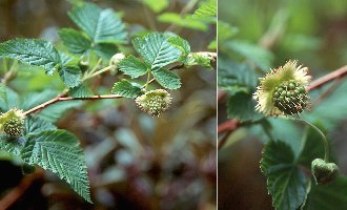Reproduction
During the life cycle of Rubus spectabilis, sexual and asexual reproduction occurs. Sexually reproduction involves seeds, where asexual reproduction involves layering, sprouting from rhizomes, and basal sprouting.
Sexual Reproduction: Flowers are pollinated by insects and hummingbirds. Eventually, drupelets are formed when pollination is successful. These drupelets are eaten by animals and they pass the seeds through the digestive tract to new sites. Most of these seeds lie dormant for many years creating a large seed bank. Under natural conditions these seeds germinate by disturbances such as wind, fire, and human activity. Within several years after germination, seedling growth approaches 20 to 30 cm per year.
| Flowers of Rubus spectabilis Formation of drupelets |


| Photos Courtesy of: Pat Breen, Oregon State Univ. |
Asexual Reproduction: There are three processes this organism can use for asexual reproduction: layering, sprouting from rhizomes, and basal sprouting. Layering is when the stem in pinned to the soil by an object, such as a large tree branch, and buds on the upper side of the stem form new aerial shoots. Adventitious roots form on the lower surface. Basal Sprouting is when the buds are located near the base of the stem or in the root crown. These buds can re-establish Salmonberries that have been destroyed or damaged. Sprouting with rhizomes is when rhizomes grow within several feet of the soil surface. They form dense, interwoven mats. Rhizomes are capable of producing buds every half to one inch, meaning a single network can contain hundreds of thousands of buds per acre.

This is a general life cycle for Salmonberries. Starting with the plant flowering, it is then pollinated and fruit production begins. As the fruit ripens, seeds are produced. These seeds, which are taken in by other animals and distributed else where, begin to germinate to form seedlings. The seedlings become young plants and growth and maturity takes place to produce adult Salmonberries. The adult plants age and eventually die. New plants grow in its place and the life cycle starts over again.
Check out other organisms with similar life cycles: Passiflora incarnata, Punica granatum, and Ilex aquifolium
<---- Previous Page Home Page Next Page ---->